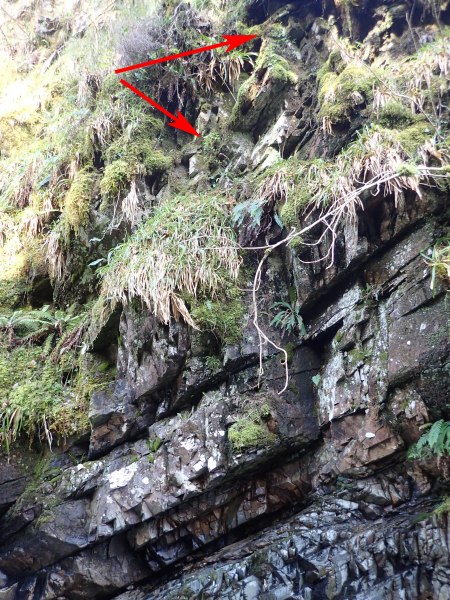Fresh snow on the hills, hail beating at the window at 8 am, yesterday was obviously the perfect day for my first serious botanical expedition of the year. In fact it turned out reasonably pleasant with just a few drops of rain now and then.
The woods of “Kinloch Ravine” to the northeast of Kinloch Farm were surveyed in 1986 but the site spreads over three tetrads in two hectads and records were not kept separate. Also not far away is the Allt nam Criopag which turns out to have a very impressive and long gorge which, apart from the lower end, can only be accessed at rather few points.
Most plants recorded from the woods were re-found yesterday and assigned to 1 km squares. A few remain that would have been nice to sort out but which were unlikely this early in the year such as Carex pallescens (Pale Sedge), Melampyrum pratense (Common Cow-wheat) and Trollius europaeus (Globeflower). However, there was a very pleasing colony of Orthilia secunda (Serrated Wintergreen), a new hectad record and only the second site in the south of Skye. It is about 5m up a vertical cliff above the river:

Kinloch site for Orthilia
With a little zoom one can see the one-sided infructescence with straight exserted styles and on one image with the eye of faith, serrated leaf margins. The only other possibility is Pyrola media (Intermediate Wintergreen) but as well as the one-sidedness and probable serrations, the general growth form is typical of Orthilia. (I wish I had had my other camera with me; it is better at the telephoto effect.)

Kinloch Orthilia
On to Allt nam Criopag where seven 1968 records from John Birks demanded a search, even though it is March. A small patch of Alchemilla alpina (Alpine Lady’s-mantle) was located whilst Arctostaphylos uva-ursi (Bearberry), Hymenophyllum wilsonii (Wilson’s Filmy-fern) and Vaccinium vitis-idaea (Cowberry) were in a number of sites – and elsewhere in the general area. Lathyrus linifolius (Bitter-vetch), Thalictrum alpinum (Alpine Meadow-rue) and Trollius europaeus (Globeflower) await another visit (maybe).
Holly had mines of the fly Phytomyza ilicis (Holly Leafminer) and on dead leaves the spore bodies of the fungus Trochila ilicina (Holly Speckle), the latter being apparently the less frequent locally.
This fungus growing on a long-dead detached lump of unidentifiable tree looked distinctive but so far I haven’t a clue as to its identity:


March 25, 2019 at 10:34 pm |
Depending on your camera type/size, you could always hold it up to a binocular eyepiece and use the whole as a giant zoom lens. Works best if you can support the binoculars on something steady (fencepost, rock, somebody’s shoulder) else the handshake will blur the shot. Unless you whack the ISO to max, I guess. Could work in bright, sunny conditions – so maybe 2 days a year up here!
Conversely, shooting through a 10x handlens gives surprisingly good results for micro stuff.
March 26, 2019 at 9:44 am |
The thing is… I don’t carry binoculars. I use the hand lens trick all the time.
April 12, 2019 at 6:54 pm |
[…] decided that I needed better images of the wintergreen at Kinloch and so on my way to Edinburgh for the BSBI Scottish Recorders Conference yesterday I went back with […]